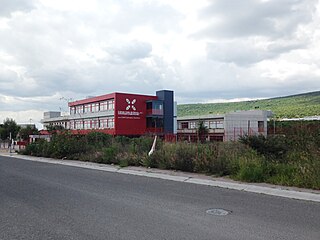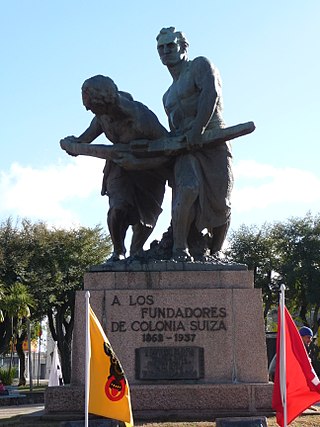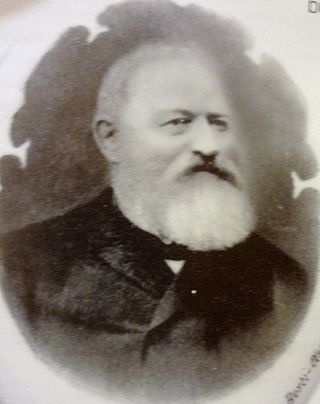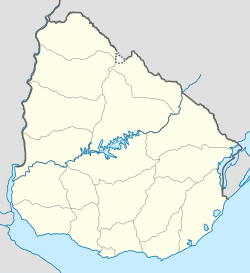
This is a demography of the population of Uruguay including population density, ethnicity, education level, health of the populace, economic status, religious affiliations and other aspects of the population.

Juan Carlos Onetti Borges was a Uruguayan novelist and author of short stories.

The Uruguayan Air Force is the air service branch of the Armed Forces of Uruguay. Originally created as part of the National Army of Uruguay, the Air Force was established as a separate branch on December 4, 1953. It is the youngest and also the smallest branch of the Armed Forces of Uruguay. In 1977 it was determined that the mission of the Air Force is to conduct strategic and tactical aerospace operations on behalf of the national defense, exercising the sovereignty of the Uruguayan airspace and defending the independence, integrity, constitution and laws of the country. The Air Force must also conduct search and rescue missions and plan, propose, execute and supervise the necessary measures for the development of the aerospace potential, while providing any necessary and possible logistical support during the natural disasters that the country may suffer. Since 1985 this has been always carried out under the command of the President of Uruguay, and according to the Minister of National Defense.
Banda Oriental, or more fully Banda Oriental del Uruguay, was the name of the South American territories east of the Uruguay River and north of Río de la Plata that comprise the modern nation of Uruguay, the modern state of Rio Grande do Sul, Brazil, and part of the modern state of Santa Catarina, Brazil. It was the easternmost territory of the Viceroyalty of the Río de la Plata.

Italian Uruguayans are Uruguayan-born citizens who are fully or partially of Italian descent, whose ancestors were Italians who emigrated to Uruguay during the Italian diaspora, or Italian-born people in Uruguay. Outside of Italy, Uruguay has one of the highest percentages of Italians in the world. It is estimated that about 44% of the total population of Uruguay are of Italian descent, corresponding to about 1,500,000 people, while there were around 90,000 Italian citizens in Uruguay.

Switzerland–Uruguay relations are foreign relations between Uruguay and Switzerland. Both countries share a long history of mutual economic relations, and they established diplomatic relations in 1828. Uruguay became a popular destination for Swiss migrants starting in the 1860s. In the 20th century, Uruguay has looked to Switzerland as a model for government, historical and cultural ties go back to at least the 19th century. There were 956 people with Swiss passports residing in Uruguay in 2008. Uruguay was described as the "Switzerland of the Americas" in a 1951 New York Times article for its popularity as a haven for capital fleeing Europe at the time and its adoption of Swiss-inspired banking laws. Thomas J. Knight also wrote that "Uruguay has for most of its history been the 'Switzerland' of South America."
Swiss Chileans are Chilean citizens of Swiss ancestry. There are currently 15,000 Swiss citizens residing in Chile, with approximately 120,000 descendants of the 19th century immigrants.
Swiss Argentines are Argentine citizens of Swiss ancestry or people who emigrated from Switzerland and reside in Argentina. The Swiss Argentine community is the largest group of the Swiss diaspora in South America.

The Popular Assembly is a left-wing political party in Uruguay.

Jorge Alberto Meyer Long is an Uruguayan diplomat, since September 1, 2014 he is ambassador in Bern.

Uruguayans are people identified with the country of Uruguay, through citizenship or descent. Uruguay is home to people of different ethnic origins. As a result, many Uruguayans do not equate their nationality with ethnicity, but with citizenship and their allegiance to Uruguay. Colloquially, primarily among other Spanish-speaking Latin American nations, Uruguayans are also referred to as "orientals [as in Easterners]".
Claudia Turbay Quintero is a Colombian journalist and diplomat. She has served as Ambassador of Colombia to Switzerland, with dual accreditation as Non-Resident Ambassador to Liechtenstein, Ambassador of Colombia to Uruguay with dual accreditation as Permanent Representative of Colombia to the Latin American Integration Association in Montevideo, and had over 27 years of experience working with Proexport, holding various positions including Commercial Director in the Miami offices, and Vice President, eventually being appointed President of the agency in 2002.
Nibia Sabalsagaray was an Uruguayan educator and activist. She was tortured and killed by the civic-military dictatorship that ruled between 1973 and 1985.

The Colegio Suizo de México, A.C. is a Swiss-education school with three campuses in Mexico. The Campus México is in Colonia del Valle, Benito Juárez, Mexico City. The Campus Cuernavaca is in Cuernavaca, Morelos. The Campus Querétaro is in Querétaro City, Querétaro. It serves levels maternal to preparatoria.

Swiss Uruguayans are Uruguayan citizens of full or partial Swiss ancestry, who remain culturally connected to Switzerland, or Swiss-born people permanently residing in Uruguay. They are estimated to be around 60,000.

Santiago Otto Schaerer Kuenzli was a Swiss emigrant, trader, settler and important colonizer in South America. He was the founder and administrator of several Swiss colonies, most prominently Nueva Helvecia in Uruguay and San Bernardino in Paraguay. He was the father of the 25th president of Paraguay Eduardo Schaerer and grandfather of businessman and journalist Arturo Schaerer.
Claudia Josefa Palacios González (?–1881) was an Uruguayan painter and miniaturist of the nineteenth century. She is best known for creating the first visual representation of Uruguayan independence episode known as Desembarco de los Treinta y Tres Orientales.

Martín Nusspaumer is a Uruguayan operatic tenor., born in Juan Lacaze, Colonia, Uruguay.
The 2023 Copa Uruguay, is the second edition of the Copa Uruguay, the country's national football cup tournament. The tournament began on 21 August 2023 and had 80 teams participating. It was originally scheduled to end on 10 December 2023, but the tournament was paused at the round of 16 and resumed on 5 February 2024 due to a players strike in Uruguayan football, with the final match eventually moved to 22 May 2024.














